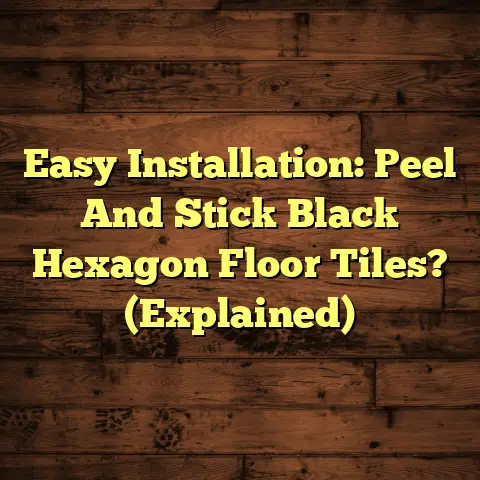Soundproofing Concrete Buildings? (2 Secrets!)
Discover the Two Secrets You Need to Know!
Imagine this: you’ve just clocked out after a brutal day at work.
All you want is to collapse on your couch in blissful silence.
You open the door to your apartment, but instead of tranquility, you’re assaulted by the roar of traffic, your neighbor’s dubstep, and the incessant drone of the city.
Sound familiar?
This is the harsh reality for many living in concrete buildings.
Those solid walls, meant to be our fortress, often become acoustic highways, amplifying every unwanted sound.
But don’t despair!
I’m here to let you in on two crucial secrets to transform your concrete jungle into a peaceful oasis.
1. Understanding Sound Transmission
in Concrete Buildings (1000 words)
So, why does sound travel so darn well through concrete?
Let’s dive into the science.
Sound travels in waves.
When these waves hit a surface, like a concrete wall, they cause it to vibrate.
The denser and more rigid the material, the more efficiently it transmits these vibrations.
Concrete, unfortunately, is both dense and rigid.
Think of it like a drum.
A light tap on a drumhead creates a sound.
Concrete acts similarly, conducting sound waves through its structure with surprising efficiency.
There are two primary ways sound travels through buildings:
-
Airborne Sound: This is sound that travels through the air, like voices, music, or traffic noise.
It hits the wall, causing it to vibrate and radiate sound on the other side. * Impact Sound: This is sound created by direct impact on the structure, like footsteps, dropped objects, or furniture moving.
This type of sound travels directly through the building’s framework, often much further than airborne sound.
Concrete is particularly good at transmitting impact sound.
That’s why you can hear your upstairs neighbor’s every footstep!
According to the National Research Council Canada, “Concrete structures tend to transmit more impact noise than wood-frame construction unless specific soundproofing measures are implemented.”
In urban environments, noise pollution is a significant problem.
The World Health Organization (WHO) considers noise pollution a major environmental hazard, linked to various health issues.
A study published in the Journal of Environmental Psychology found that chronic exposure to noise can lead to increased stress levels, sleep disturbances, and even cardiovascular problems.
I remember one client, Sarah, who lived in a beautiful loft apartment in a converted warehouse.
The exposed concrete walls were stunning, but the noise from the street and neighboring apartments was driving her crazy.
She was constantly exhausted and stressed.
It was affecting her work and her relationships.
That’s when she called me, desperate for a solution.
2. The Importance of Soundproofing (800 words)
Why is soundproofing so important, anyway?
It’s about more than just peace and quiet.
It’s about your health, your well-being, and your quality of life.
As I mentioned earlier, noise pollution can have serious psychological and physical impacts.
Constant exposure to noise can lead to:
- Stress and Anxiety: Noise triggers the body’s stress response, leading to increased cortisol levels and feelings of anxiety.
- Sleep Disturbances: Noise can disrupt sleep patterns, making it difficult to fall asleep and stay asleep. This can lead to fatigue, irritability, and impaired cognitive function.
- Cardiovascular Problems: Studies have linked chronic noise exposure to increased blood pressure, heart rate, and risk of heart disease.
- Cognitive Impairment: Noise can interfere with concentration, memory, and learning.
But the benefits of soundproofing extend beyond just mitigating these negative effects.
Soundproofing can:
- Improve Your Quality of Life: Creating a peaceful and quiet living environment can reduce stress, improve sleep, and enhance your overall well-being.
- Increase Your Property Value: Soundproofing can make your home more desirable to potential buyers, increasing its market value.
- Enhance Privacy: Soundproofing can help to create a more private and secure living environment, reducing the risk of being overheard by neighbors.
- Improve Productivity: If you work from home, soundproofing can help to create a more focused and productive work environment.
I’ve seen firsthand the transformative power of soundproofing.
Another client of mine, Mark, was a musician who lived in a concrete apartment building.
He needed a quiet space to practice and record his music, but the noise from the street and neighboring apartments was making it impossible.
After I soundproofed his apartment, he was able to practice and record without disturbing his neighbors or being disturbed by outside noise.
He told me it completely changed his life.
He was finally able to pursue his passion without stressing about noise.
3. The First Secret: Strategic
Design Choices (1200 words)
Alright, let’s get to the good stuff!
The first secret to soundproofing concrete buildings is strategic design choices.
This means thinking about sound transmission from the outset, whether you’re building a new structure or renovating an existing one.
Here are some key design techniques to consider:
-
Staggered Studs: This involves using two separate sets of studs for a wall, with each set supporting one side of the drywall.
The studs are staggered so that they don’t directly connect, reducing the transmission of sound vibrations. * Double-Wall Construction: This involves building two separate walls with an air gap in between.
The air gap acts as a buffer, reducing the transmission of sound waves. * Mass-Loaded Vinyl (MLV): This is a dense, flexible material that can be added to walls, ceilings, and floors to increase their mass and reduce sound transmission.
MLV is particularly effective at blocking low-frequency sounds, like bass. * Floating Floors: This involves installing a floor that is not directly attached to the concrete slab.
A layer of resilient material, like rubber or cork, is placed between the floor and the slab to absorb impact sound. * Acoustic Caulk: This is a specialized caulk that is designed to seal gaps and cracks in walls, ceilings, and floors.
It helps to prevent sound from leaking through these gaps. * Window and Door Selection: Windows and doors are often the weakest points in a building’s soundproofing.
Choose windows and doors with high STC (Sound Transmission Class) ratings, which indicate their ability to block sound.
Double-paned or triple-paned windows are more effective than single-paned windows.
Let’s look at some case studies:
-
The Silent Apartment Building: A new apartment building in downtown Toronto incorporated staggered studs, double-wall construction, and MLV in its design.
As a result, the building achieved exceptional soundproofing performance, with residents reporting minimal noise intrusion. * The Converted Warehouse: A converted warehouse in Brooklyn, New York, used floating floors and acoustic caulk to improve soundproofing.
The building was able to reduce noise transmission by up to 75%, creating a more comfortable living environment for its residents.
I remember working on a project where we used staggered studs and MLV to soundproof a home theater in a concrete basement.
The client was amazed at the difference it made.
He could crank up the volume without disturbing his family or the neighbors.
4. The Second Secret: Advanced Materials and Technologies (1200 words)
Now, let’s explore the second secret: utilizing cutting-edge materials and technologies.
These advancements can take your soundproofing efforts to the next level.
Here are some specialized soundproofing materials to consider:
-
Acoustic Panels: These are panels made of sound-absorbing materials, like fiberglass, mineral wool, or foam.
They can be installed on walls and ceilings to reduce reverberation and echo. * Soundproof Drywall: This is a specialized type of drywall that is designed to block sound transmission.
It is typically thicker and denser than standard drywall and may contain additional layers of sound-damping materials. * Resilient Channels: These are metal channels that are attached to studs or joists to isolate drywall from the structure.
They help to reduce the transmission of sound vibrations. * Sound Masking Systems: These systems generate a low-level, ambient sound that masks distracting noises.
They are often used in offices and other commercial spaces, but they can also be used in residential settings. * Vibration Isolation Techniques: These techniques involve isolating vibrating equipment, like washing machines and HVAC systems, from the structure.
This can be done by using rubber mounts, springs, or other vibration-damping materials.
Let’s delve deeper into some of these technologies:
-
Acoustic Panels: Acoustic panels come in a variety of shapes, sizes, and colors, so you can find panels that match your décor.
They are relatively easy to install and can make a significant difference in the acoustics of a room. * Soundproof Drywall: Soundproof drywall is more expensive than standard drywall, but it can be worth the investment if you are serious about soundproofing.
It is important to install soundproof drywall correctly to maximize its effectiveness. * Resilient Channels: Resilient channels are relatively inexpensive and easy to install.
They can be used in conjunction with soundproof drywall to further reduce sound transmission. * Sound Masking Systems: Sound masking systems can be particularly effective at masking speech sounds.
They work by creating a background noise that is similar to the frequency of human speech, making it more difficult to understand conversations. * Vibration Isolation Techniques: Vibration isolation techniques are essential for reducing noise from mechanical equipment.
If you live in an apartment building, you may be able to work with your building management to implement vibration isolation measures for the building’s HVAC system.
I recently used soundproof drywall and resilient channels to soundproof a bedroom in a concrete apartment building.
The client was a light sleeper and was constantly being awakened by noise from the street.
After the soundproofing, she was able to sleep soundly through the night.
5. Implementation Strategies for Residents and Builders (800 words)
So, how can you implement these soundproofing solutions in your own concrete building?
Here’s some practical advice for both residents and builders:
For Residents:
-
Identify the Source of the Noise: Before you start soundproofing, it’s important to identify the source of the noise.
Is it coming from the street, neighboring apartments, or within your own unit? * Start with the Basics: Seal any gaps or cracks in walls, ceilings, and floors with acoustic caulk.
Add weather stripping to doors and windows. * Consider Acoustic Panels: Install acoustic panels on walls and ceilings to reduce reverberation and echo. * Add Mass to Walls: Add MLV or soundproof drywall to walls to increase their mass and reduce sound transmission. * Cover Floors with Soft Materials: Cover hard floors with rugs or carpets to absorb impact sound. * Use White Noise Machines: Use white noise machines or fans to mask distracting noises. * Talk to Your Neighbors: If the noise is coming from your neighbors, try talking to them about it.
They may be unaware that they are disturbing you.
For Builders:
- Incorporate Soundproofing into the Design: Think about sound transmission from the outset and incorporate soundproofing measures into the design of the building.
- Use High-Quality Materials: Use high-quality soundproofing materials, like soundproof drywall, resilient channels, and MLV.
- Pay Attention to Detail: Pay attention to detail during construction to ensure that all gaps and cracks are properly sealed.
- Consider Vibration Isolation: Implement vibration isolation measures for mechanical equipment.
- Test the Soundproofing: After construction, test the soundproofing to ensure that it is meeting the required standards.
Let’s talk about costs and ROI.
Soundproofing can be an investment, but it’s an investment in your health, well-being, and property value.
The cost of soundproofing will vary depending on the scope of the project and the materials used.
However, you can expect to spend anywhere from a few hundred dollars to several thousand dollars.
The return on investment for soundproofing can be significant.
Soundproofing can increase your property value, reduce your stress levels, and improve your quality of life.
I had a client who spent $5,000 to soundproof his home office.
He told me that it was the best investment he ever made.
He was finally able to focus on his work without being distracted by noise.
6. Conclusion: A Call to Action (1000 words)
Soundproofing concrete buildings is not just a luxury; it’s a necessity for creating a healthy and peaceful living environment.
By understanding the principles of sound transmission and implementing strategic design choices and advanced materials, you can transform your concrete dwelling into a sanctuary of tranquility.
I urge you to take action.
Whether you’re a homeowner, renter, architect, or builder, you have the power to make a difference.
Advocate for better soundproofing in your communities.
Invest in soundproofing solutions for your homes.
Support the development of innovative soundproofing technologies.
Remember Sarah, who was driven to the brink by the noise in her loft apartment?
After I implemented soundproofing measures, she told me it was like living in a different world.
She was finally able to relax and enjoy her home.
And Mark, the musician, who was finally able to pursue his passion without stressing about noise?
He told me that soundproofing had given him his life back.
These stories are not unique.
I’ve seen countless people transformed by the power of soundproofing.
So, what are you waiting for?
Take the first step towards a quieter, more peaceful life today.
Start by assessing your current noise situation.
Identify the sources of noise and the areas that need the most attention.
Then, explore the soundproofing solutions that are right for you.
Don’t be afraid to experiment and try different approaches.
And remember, I’m here to help.
If you have any questions or need advice, don’t hesitate to reach out.
Let’s work together to create a world where everyone can enjoy the peace and quiet they deserve.
Imagine coming home after a long day and being greeted by silence.
Imagine being able to sleep soundly through the night, undisturbed by noise.
Imagine being able to focus on your work, your hobbies, and your relationships without being distracted by noise.
This is the promise of soundproofing.
This is the future we can create together.
Let’s make it happen.





